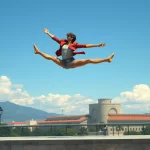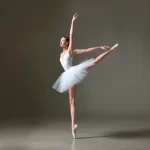Fondu: Melting into the Movement

Introduction
In the world of ballet, each movement is a testament to the dancer’s grace, strength, and technical prowess. One such movement that epitomizes these qualities is the Fondu. Derived from the French word for “melt,” the Fondu is a fundamental ballet move that requires a dancer to lower their body by bending the knee of the supporting leg while extending the working leg. This movement is not just a technical exercise but a beautiful expression of fluidity and control.
The importance of the Fondu in ballet cannot be overstated. It serves as a building block for more complex movements and is essential for developing balance, coordination, and strength. Whether you are a beginner or an advanced dancer, mastering the Fondu is crucial for your overall development in ballet.
In this article, we will delve into the historical background of the Fondu, provide a technical breakdown of how to perform it, discuss key elements of technique, highlight common mistakes and how to avoid them, explore its applications in choreography, and offer training exercises to help you master this elegant movement. Additionally, we will address frequently asked questions to provide a comprehensive understanding of the Fondu.
Historical Background
The origins of the Fondu can be traced back to the early days of ballet in the 15th and 16th centuries. Ballet itself originated in the Italian Renaissance courts and later flourished in France under the patronage of King Louis XIV. The term “Fondu” was first used in the French court to describe a movement that involved a melting or sinking action, reflecting the fluidity and grace that are hallmarks of ballet.
Over time, the Fondu evolved as ballet techniques became more refined and codified. It became an integral part of the classical ballet vocabulary, used in various combinations and sequences. Notable choreographers such as Marius Petipa and George Balanchine have incorporated the Fondu into their works, showcasing its versatility and beauty.
Renowned dancers like Anna Pavlova and Rudolf Nureyev have also been associated with the Fondu, demonstrating its importance in both classical and contemporary ballet. Their performances have inspired generations of dancers to master this essential movement.
Technical Breakdown
Step-by-Step Explanation
Performing a Fondu requires precision and control. Here is a detailed step-by-step explanation:
- Starting Position: Begin in the fifth position, with your feet turned out and heels touching.
- Preparation: Extend your working leg to the front, side, or back, depending on the desired direction of the Fondu.
- Bend the Supporting Knee: Slowly bend the knee of your supporting leg, allowing your body to lower smoothly. Ensure that your working leg remains extended and pointed.
- Reach the Lowest Point: Continue bending until you reach the lowest point of the Fondu. Your supporting leg should form a deep plié, while your working leg remains fully extended.
- Rise Up: Gradually straighten your supporting leg, bringing your body back to the starting position. Maintain control and balance throughout the movement.
Key Positions and Transitions
The Fondu involves several key positions and transitions:
- Fifth Position: The starting and ending position, with feet turned out and heels touching.
- Extension: The working leg is extended to the front (devant), side (à la seconde), or back (derrière).
- Plié: The supporting leg bends deeply, allowing the body to lower smoothly.
- Relevé: The rise back to the starting position, with the supporting leg straightening.
Common Variations
The Fondu can be performed in various directions and combinations:
- Fondu Devant: The working leg extends to the front.
- Fondu à la Seconde: The working leg extends to the side.
- Fondu Derrière: The working leg extends to the back.
- Fondu en Croix: A combination of all three directions, performed in a cross pattern.
Key Elements of Technique
Balance
Maintaining balance during a Fondu is crucial. Focus on engaging your core muscles and keeping your weight centered over the supporting leg. Practice balancing exercises, such as standing on one leg, to improve your stability.
Posture
Proper body alignment and positioning are essential for executing a Fondu correctly. Keep your back straight, shoulders down, and head held high. Ensure that your hips remain level and square throughout the movement.
Timing
Understanding the rhythm and timing of a Fondu is vital. The movement should be smooth and controlled, with a gradual descent and ascent. Practice with music to develop a sense of timing and coordination.
Strength and Flexibility
The muscles involved in a Fondu include the quadriceps, hamstrings, glutes, and calves. Strengthening these muscles through targeted exercises, such as squats and lunges, will enhance your ability to perform a Fondu. Additionally, flexibility in the hips and ankles is important for achieving the full range of motion.
Common Mistakes and How to Avoid Them
Here are some frequent errors dancers make when performing a Fondu and tips to prevent them:
- Incorrect Alignment: Ensure that your hips remain level and square. Avoid tilting or twisting your pelvis.
- Rushed Movement: Take your time to perform the Fondu smoothly and with control. Avoid rushing through the movement.
- Weak Supporting Leg: Strengthen your supporting leg through targeted exercises to maintain stability and balance.
- Improper Extension: Fully extend your working leg and point your toes. Avoid letting your foot droop or lose its shape.
Applications in Choreography
The Fondu is a versatile movement used in various ballet styles and pieces. Here are some examples:
- Swan Lake: The Fondu is prominently featured in the pas de deux between Odette and Prince Siegfried, showcasing the fluidity and grace of the dancers.
- The Nutcracker: The Sugar Plum Fairy’s solo includes several Fondu variations, highlighting the dancer’s technical prowess.
- Contemporary Ballet: Choreographers like William Forsythe and Jiří Kylián incorporate the Fondu into their works, blending classical technique with modern movements.
Training Exercises
Exercises and Drills
To master the Fondu, incorporate these exercises into your training routine:
- Plié Squats: Perform deep plié squats to strengthen your quadriceps and glutes.
- Single-Leg Balances: Practice balancing on one leg to improve stability and control.
- Leg Extensions: Perform leg extensions to enhance the strength and flexibility of your working leg.
- Calf Raises: Strengthen your calves by performing calf raises, both on flat feet and on relevé.
Conditioning Routines
Incorporate these conditioning routines to support the required strength and flexibility for a Fondu:
- Yoga: Practice yoga to improve flexibility, balance, and core strength.
- Pilates: Incorporate Pilates exercises to strengthen your core and improve overall body alignment.
- Stretching: Perform regular stretching routines to enhance flexibility in your hips, hamstrings, and calves.
FAQ
How long does it take to master Fondu?
The time it takes to master a Fondu varies depending on the dancer’s experience and dedication. With consistent practice and proper technique, most dancers can achieve proficiency within a few months. However, mastering the nuances and achieving a flawless execution may take years of practice.
What are the most important muscles to strengthen for Fondu?
The most important muscles to strengthen for a Fondu include the quadriceps, hamstrings, glutes, and calves. Additionally, core strength is essential for maintaining balance and stability during the movement.
Can beginners attempt Fondu?
Yes, beginners can attempt a Fondu. It is a fundamental movement in ballet and is often introduced early in training. However, beginners should focus on proper technique and gradually build strength and flexibility to perform the movement correctly.
What are some common injuries associated with Fondu?
Common injuries associated with a Fondu include knee strain, ankle sprains, and muscle strains. To prevent injuries, ensure proper warm-up, maintain correct alignment, and avoid overexertion. Strengthening the supporting muscles and practicing proper technique are also crucial for injury prevention.
How can I improve my technique for Fondu?
To improve your technique for a Fondu, focus on the following:
- Practice Regularly: Consistent practice is key to mastering any ballet movement.
- Seek Feedback: Work with a ballet instructor to receive feedback and corrections on your technique.
- Strengthen Supporting Muscles: Incorporate targeted exercises to strengthen the muscles involved in a Fondu.
- Work on Flexibility: Perform regular stretching routines to enhance flexibility in your hips, hamstrings, and calves.
- Focus on Balance: Practice balancing exercises to improve stability and control.
Conclusion
The Fondu is a beautiful and essential movement in ballet that requires grace, strength, and precision. By understanding its historical background, mastering the technical breakdown, focusing on key elements of technique, avoiding common mistakes, and incorporating training exercises, dancers can achieve proficiency in this elegant movement. Whether you are a beginner or an advanced dancer, the Fondu is a fundamental building block that will enhance your overall ballet technique. Keep practicing, stay dedicated, and let yourself melt into the movement of the Fondu.




